Why You Need a Personal Firewall and How to Set It Up

As cyber threats continue to grow, protecting your personal information online has become more critical than ever. A personal firewall is a fundamental tool that helps safeguard your computer from unauthorized access, ensuring your data remains secure. This article explores the importance of personal firewalls and provides a step-by-step guide on how to set one up effectively.
Understanding the Need for a Personal Firewall
A personal firewall acts as a barrier between your computer and potential cyber threats. It monitors incoming and outgoing network traffic and blocks suspicious activities based on pre-defined security rules. This protection is crucial because it prevents hackers from accessing your system remotely and shields sensitive data from malware and other malicious software.
One key reason for using a personal firewall is to control what goes in and out of your computer. Without this protection, any open port can be an entry point for hackers. For example, in 2017, the WannaCry ransomware attack exploited vulnerabilities in unprotected systems, affecting over 200,000 computers worldwide (source: BBC). A robust firewall could have significantly mitigated such risks by monitoring and blocking unauthorized access.
Personal firewalls also offer customization options to suit individual needs. You can set specific rules to allow or block certain types of traffic, giving you granular control over your network security. This flexibility makes personal firewalls an indispensable tool for both novice users and advanced tech enthusiasts.
Key Features of Personal Firewalls
When selecting a personal firewall, it's essential to understand the key features that make them effective. Here are some critical elements to look for:
- Intrusion Detection: Identifies suspicious activities and alerts you to potential threats.
- Application Control: Manages which applications can access the internet, preventing unauthorized programs from transmitting data.
- Packet Filtering: Analyzes incoming and outgoing packets of data to block harmful content.
- Logging and Reporting: Keeps detailed logs of network activity, helping you monitor and analyze security events.
Additionally, many modern firewalls come with user-friendly interfaces that simplify setup and management. Some popular options include ZoneAlarm, Norton Personal Firewall, and Comodo Firewall, each offering unique features tailored to different user needs (source: PCMag).
Setting Up Your Personal Firewall
Installing and configuring a personal firewall may seem daunting, but following these steps can make the process straightforward:
- Select a Firewall: Choose a reputable firewall that fits your requirements. Free options like Windows Defender Firewall offer basic protection, while paid versions provide advanced features.
- Download and Install: Visit the official website of your chosen firewall provider and download the latest version. Follow the installation instructions provided.
- Configure Settings: Once installed, open the firewall application and navigate through the settings menu. Set up basic rules for incoming and outgoing traffic, enable intrusion detection features, and configure application control as needed.
- Create Custom Rules: Customize rules based on your specific needs. For example, you might want to block certain applications from accessing the internet or allow only specific IP addresses to connect to your system.
- Regular Updates: Keep your firewall updated with the latest security patches to ensure ongoing protection against new threats.
Troubleshooting Common Issues
Even with proper setup, you might encounter some issues with your personal firewall. Here are some common problems and how to resolve them:
| Issue | Solution |
|---|---|
| Blocked Legitimate Applications | Add the application to the firewall's whitelist or adjust its permissions manually. |
| Slow Internet Connection | Review firewall rules to ensure they are not overly restrictive or adjust bandwidth settings if available. |
| Error Messages During Setup | Check for software compatibility issues or consult the firewall's support documentation for troubleshooting tips. |
| No Alerts or Notifications | Ensure alert settings are enabled in the firewall configuration menu. |
If issues persist, consider reaching out to customer support for your specific firewall product or seeking assistance from online forums where experienced users share solutions (source: Reddit).
A personal firewall is an essential tool in protecting your computer from cyber threats. By monitoring network traffic and blocking unauthorized access attempts, it helps keep your data secure from hackers and malware. Understanding its importance allows users to take proactive steps in securing their devices. Setting up a personal firewall involves choosing the right software, configuring settings appropriately, creating custom rules based on individual needs, and keeping the software updated regularly. Troubleshooting common issues ensures smooth operation and continuous protection. By incorporating these practices into daily routines, users can enhance their online security significantly.